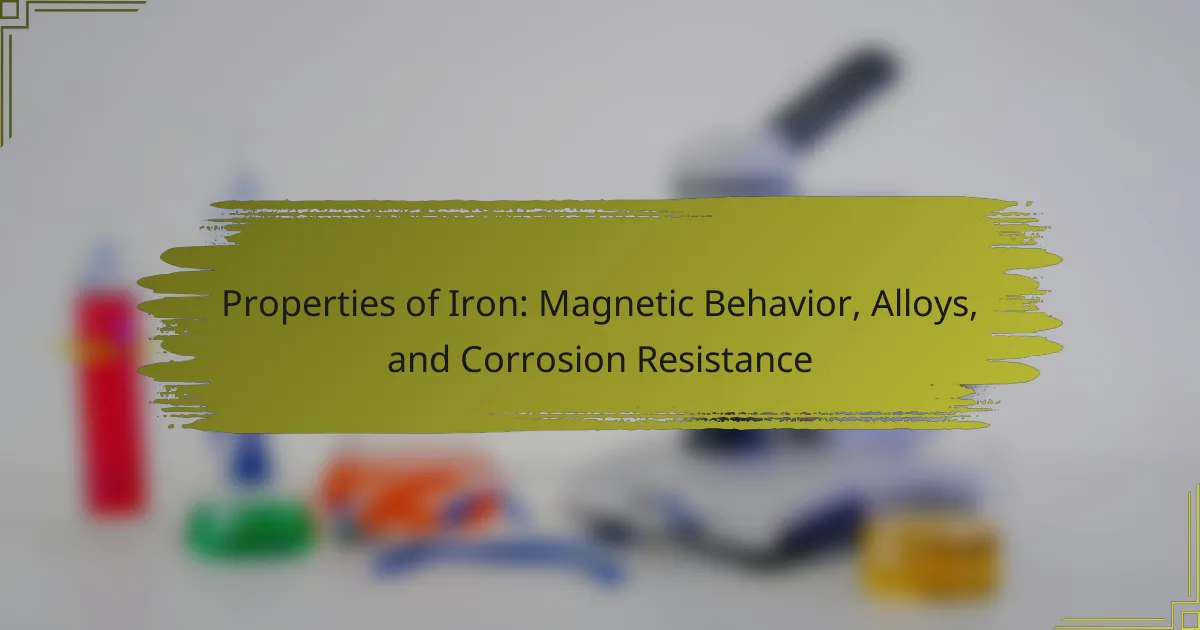
What are the fundamental properties of iron?
Iron is a metal known for its fundamental properties. It has high tensile strength, making it durable and strong. Iron is also malleable, allowing it to be shaped without breaking. Additionally, it is ductile, which means it can be drawn into wires. Iron exhibits magnetic properties, particularly in its pure form. It has a relatively high melting point of about 1538 degrees Celsius. Iron is reactive and can oxidize, leading to rust formation in moist environments. Its density is approximately 7.87 grams per cubic centimeter. These properties make iron essential in construction and manufacturing.
How does iron exhibit magnetic behavior?
Iron exhibits magnetic behavior due to its ferromagnetic properties. This means that iron can become magnetized when exposed to a magnetic field. The atomic structure of iron contains unpaired electrons. These unpaired electrons create magnetic moments that align in the presence of an external magnetic field. When the field is removed, some alignment remains, resulting in permanent magnetism. The Curie temperature for iron is approximately 770 degrees Celsius. Above this temperature, iron loses its magnetic properties. This behavior is fundamental in various applications, including electromagnets and magnetic storage devices.
What are the types of magnetic properties in iron?
Iron exhibits three primary types of magnetic properties: ferromagnetism, paramagnetism, and diamagnetism. Ferromagnetism is the strongest type of magnetism found in iron. In this state, iron atoms align their magnetic moments in the same direction, resulting in strong magnetic fields. This property is responsible for the permanent magnets made from iron alloys.
Paramagnetism occurs in iron at high temperatures. In this state, iron atoms have unpaired electrons that align with external magnetic fields, but this alignment is weak and temporary. When the external field is removed, the magnetic moments return to random orientations.
Diamagnetism is a weak form of magnetism present in iron. This property arises from the change in electron motion in response to an external magnetic field, creating a very weak repulsion. However, this effect is usually overshadowed by the stronger ferromagnetic behavior.
These magnetic properties of iron are essential in various applications, including electrical engineering and materials science.
How does temperature affect the magnetic properties of iron?
Temperature significantly affects the magnetic properties of iron. As temperature increases, iron transitions from a ferromagnetic state to a paramagnetic state. This change occurs around the Curie temperature, which is approximately 770 degrees Celsius for pure iron. Below this temperature, iron exhibits strong magnetic properties due to aligned magnetic domains. Above the Curie temperature, thermal agitation disrupts this alignment, reducing magnetism. The loss of magnetic properties at elevated temperatures is a well-documented phenomenon in materials science. This behavior is critical in applications where temperature variations occur, affecting the performance of iron-based materials.
What types of alloys can be made from iron?
Iron can form several types of alloys, including carbon steel, stainless steel, and cast iron. Carbon steel is primarily composed of iron and carbon, offering strength and durability. Stainless steel contains iron, carbon, and at least 10.5% chromium, providing corrosion resistance. Cast iron is an alloy of iron, carbon, and silicon, known for its excellent castability and wear resistance. Other alloys include wrought iron, which has low carbon content and is malleable, and tool steel, which is designed for high hardness and wear resistance. These alloys are utilized in various applications, from construction to manufacturing tools.
What are the most common iron alloys and their applications?
The most common iron alloys include carbon steel, cast iron, and stainless steel. Carbon steel is primarily used for construction and manufacturing due to its strength and durability. Cast iron is often utilized in cookware and pipes because of its excellent casting properties. Stainless steel is widely applied in kitchenware and medical instruments due to its corrosion resistance. Each alloy has specific compositions that enhance its performance in various applications. For instance, carbon content in carbon steel affects its hardness and tensile strength. Cast iron’s high carbon content provides fluidity during casting. Stainless steel contains chromium, which forms a protective layer against rust. These properties make these alloys suitable for a range of industrial and domestic purposes.
How do different alloying elements affect the properties of iron?
Alloying elements significantly influence the properties of iron. Carbon, for example, increases hardness and strength through the formation of cementite. Manganese enhances toughness and wear resistance, while also improving hardenability. Chromium provides corrosion resistance and increases hardness, particularly in stainless steels. Nickel adds toughness and ductility, making iron more malleable. Copper improves resistance to atmospheric corrosion. Each of these elements alters the microstructure of iron, resulting in distinct physical and mechanical properties. For instance, the addition of 0.8% carbon transforms iron into steel, which has a higher tensile strength compared to pure iron.
What is the significance of corrosion resistance in iron?
Corrosion resistance in iron is significant because it enhances the material’s durability and longevity. Corrosion leads to the deterioration of iron, resulting in structural weaknesses. Iron with high corrosion resistance can withstand environmental factors such as moisture and chemicals. This property is crucial for various applications, including construction and automotive industries. For instance, galvanized iron is coated with zinc to prevent rusting. This treatment significantly extends the lifespan of iron products. Studies show that corrosion can reduce the lifespan of iron structures by up to 50%. Therefore, corrosion resistance is vital for maintaining safety and reducing maintenance costs.
How does corrosion occur in iron?
Corrosion in iron occurs primarily through oxidation. When iron is exposed to moisture and oxygen, it reacts to form iron oxide, commonly known as rust. This process is electrochemical in nature. It involves the transfer of electrons from iron to oxygen. The presence of water accelerates this reaction by facilitating the movement of ions. Additionally, impurities and salts can increase the corrosion rate. According to the National Association of Corrosion Engineers, corrosion can lead to significant structural damage. Proper protective coatings can mitigate this phenomenon.
What methods are used to enhance corrosion resistance in iron?
Methods to enhance corrosion resistance in iron include galvanization, alloying, and protective coatings. Galvanization involves coating iron with zinc, which acts as a sacrificial anode. This method significantly reduces rust formation. Alloying iron with elements like chromium creates stainless steel, which is highly resistant to corrosion. Protective coatings, such as paints or varnishes, provide a barrier against moisture and corrosive agents. These methods are widely used in various industries to prolong the lifespan of iron products.
How do the properties of iron contribute to its applications?
Iron’s properties significantly influence its various applications. Its high tensile strength makes it ideal for construction and manufacturing. Iron’s magnetic properties enable its use in electrical applications, such as transformers and motors. The ability to form alloys, like steel, enhances its versatility and strength for diverse uses. Additionally, iron’s relatively low cost contributes to its widespread adoption in industries. Corrosion resistance can be improved through coatings and alloying, extending its lifespan in harsh environments. These properties collectively establish iron as a fundamental material across multiple sectors.

What are the specific magnetic behaviors of iron?
Iron exhibits ferromagnetism, meaning it can be magnetized and retain magnetic properties. This behavior arises from the alignment of magnetic moments of iron atoms. Iron has a high magnetic permeability, allowing it to easily become magnetized in the presence of a magnetic field. The Curie temperature of iron is approximately 770°C, above which it loses its ferromagnetic properties. Iron can also exhibit paramagnetic behavior at elevated temperatures. This means that while it can be weakly attracted to a magnetic field, it does not retain magnetization once the field is removed. Additionally, iron’s magnetic behaviors can be influenced by alloying elements. For example, the presence of carbon in steel affects its magnetic properties.
Why does iron have ferromagnetic properties?
Iron exhibits ferromagnetic properties due to its atomic structure and electron configuration. In iron, unpaired electrons in the d-orbitals allow for strong magnetic moments. These moments align parallel to each other in the presence of an external magnetic field. This alignment results in a net magnetic moment, giving iron its ferromagnetic behavior. Additionally, iron’s crystal structure, specifically the body-centered cubic (BCC) and face-centered cubic (FCC) arrangements, supports this alignment. Historical studies, such as those by Weiss in 1907, demonstrated the alignment of atomic spins in ferromagnetic materials. This phenomenon is crucial for various applications, including electromagnets and magnetic storage devices.
What is the role of electron configuration in iron’s magnetism?
Electron configuration plays a crucial role in iron’s magnetism. Iron has an electron configuration of [Ar] 3d6 4s2. This configuration leads to unpaired electrons in the 3d orbital. Unpaired electrons contribute to magnetic moments. These magnetic moments align in the presence of an external magnetic field. The alignment results in ferromagnetism, a key characteristic of iron. Additionally, iron’s ability to retain magnetization after the external field is removed is due to its electron configuration. This property is essential for various applications, including magnetic materials and electronics.
How does the crystal structure of iron influence its magnetic properties?
The crystal structure of iron significantly influences its magnetic properties. Iron typically exists in two primary crystal structures: body-centered cubic (BCC) and face-centered cubic (FCC). The BCC structure, which is stable at room temperature, allows for a higher magnetic moment due to its arrangement of atoms. This structure facilitates the alignment of magnetic domains, enhancing ferromagnetism.
In contrast, the FCC structure, which occurs at higher temperatures, has a lower magnetic moment. The atomic arrangement in FCC does not support strong magnetic domain alignment. This results in a decrease in ferromagnetic properties.
The transition between these structures affects the magnetic behavior of iron as it is heated. For example, when iron is heated past its Curie temperature, it transitions from ferromagnetic to paramagnetic behavior. This change is directly linked to the crystal structure’s influence on the atomic interactions responsible for magnetism. Overall, the crystal structure is crucial in determining the strength and type of magnetic properties exhibited by iron.
What are the practical applications of iron’s magnetic properties?
Iron’s magnetic properties have several practical applications. They are utilized in the manufacturing of transformers. Transformers rely on iron’s ability to efficiently conduct magnetic fields. This enhances energy transfer in electrical systems. Iron is also essential in the production of electric motors. Electric motors convert electrical energy into mechanical energy using magnetic fields. Additionally, iron is used in magnetic storage media, such as hard drives. These devices rely on iron’s magnetic properties to store data. Furthermore, iron is crucial in the creation of magnetic sensors. These sensors detect changes in magnetic fields for various applications. Overall, iron’s magnetic properties are foundational in multiple technological domains.
How is iron used in electrical applications due to its magnetism?
Iron is used in electrical applications primarily due to its magnetic properties. Its ferromagnetic nature allows for efficient magnetic field generation and manipulation. Iron is commonly utilized in transformers and inductors. These components rely on iron’s ability to concentrate magnetic flux. This concentration improves energy efficiency in electrical devices. Additionally, iron is used in electromagnets. Electromagnets convert electrical energy into magnetic energy effectively. The high permeability of iron enhances its performance in these applications. Overall, iron’s magnetism is fundamental to its role in electrical engineering.
What industries rely on iron’s magnetic behavior?
The industries that rely on iron’s magnetic behavior include electrical engineering, telecommunications, and manufacturing. Electrical engineering uses iron in transformers and inductors due to its magnetic properties. Telecommunications rely on iron in signal processing and data transmission equipment. Manufacturing employs iron for various applications, including electric motors and magnetic storage devices. The magnetic behavior of iron allows for efficient energy conversion and signal modulation in these sectors.

How do iron alloys enhance performance in various applications?
Iron alloys enhance performance by improving strength, ductility, and resistance to corrosion. These enhancements make iron alloys suitable for various applications, including construction, automotive, and aerospace industries. For instance, steel, an iron alloy, exhibits higher tensile strength compared to pure iron. This allows for the construction of taller buildings and more durable bridges. Additionally, alloying elements like chromium and nickel provide corrosion resistance in environments where pure iron would rust quickly. The presence of carbon in steel increases hardness, making it ideal for tools and machinery. Overall, iron alloys are engineered to meet specific requirements across multiple sectors, demonstrating their versatility and performance advantages.
What are the benefits of using iron alloys over pure iron?
Iron alloys offer several benefits over pure iron. They exhibit enhanced strength and durability. This makes them suitable for construction and manufacturing applications. Iron alloys resist corrosion better than pure iron. For instance, stainless steel, an iron alloy, contains chromium that prevents rust. Additionally, iron alloys have improved machinability. This allows for easier shaping and fabrication processes. The presence of other metals in alloys can also enhance magnetic properties. Overall, iron alloys provide superior performance in various environments compared to pure iron.
How do specific alloy compositions improve mechanical properties?
Specific alloy compositions improve mechanical properties by altering the material’s microstructure and phase distribution. For instance, adding carbon to iron creates steel, which significantly enhances strength and hardness. The presence of elements like manganese can improve ductility and toughness. Nickel additions enhance corrosion resistance while maintaining strength. Each alloying element contributes unique characteristics that optimize performance for specific applications. Research shows that optimized compositions can increase tensile strength by up to 50% compared to pure iron. These improvements are critical in industries requiring high-performance materials, such as aerospace and automotive sectors.
What are the most notable applications of iron alloys?
Iron alloys are widely used in various applications due to their enhanced properties. Notable applications include construction materials, such as beams and reinforcements. These alloys provide strength and durability in buildings and bridges. Automotive manufacturing utilizes iron alloys for engine components and chassis. This enhances performance and safety in vehicles. Additionally, iron alloys are used in tools and machinery for their toughness and wear resistance. They are also essential in the production of electrical equipment due to their magnetic properties. Iron alloys are integral in the production of pipes and fittings for plumbing systems. Their corrosion resistance extends the lifespan of these applications.
How do different processing techniques affect iron alloys?
Different processing techniques significantly impact the properties of iron alloys. Techniques such as casting, forging, and heat treatment alter the microstructure of the alloys. For instance, casting can lead to a more uniform distribution of carbon, which enhances strength. Forging typically improves ductility and toughness due to refined grain structure. Heat treatment processes like quenching and tempering can increase hardness while reducing brittleness. These changes directly affect performance characteristics like corrosion resistance and magnetic behavior. Studies show that the processing method can change the alloy’s response to environmental factors. For example, heat-treated iron alloys often exhibit improved corrosion resistance due to a denser microstructure.
What is the impact of heat treatment on iron alloys?
Heat treatment significantly alters the properties of iron alloys. It enhances mechanical strength, ductility, and toughness. The process involves heating the alloy to a specific temperature and then cooling it at controlled rates. This alters the microstructure of the alloy, leading to improved performance. For instance, quenching increases hardness but may reduce ductility. Tempering can restore some ductility while maintaining hardness. Studies show that heat-treated iron alloys exhibit superior fatigue resistance. This is crucial in applications where durability is essential, such as in automotive and aerospace industries.
How does alloying affect the machinability of iron?
Alloying affects the machinability of iron by altering its physical and mechanical properties. The introduction of alloying elements can enhance or reduce machinability. For example, elements like sulfur and lead improve machinability by promoting chip formation. Conversely, elements such as chromium and nickel can make iron harder and less machinable.
Research shows that the machinability index of iron can vary significantly with different alloy compositions. For instance, studies indicate that adding 0.1% sulfur can increase machinability by over 20%. The presence of certain alloying elements can also influence tool wear rates during machining processes.
Therefore, the choice of alloying elements is crucial for optimizing the machinability of iron.
What best practices can enhance the corrosion resistance of iron?
To enhance the corrosion resistance of iron, applying protective coatings is essential. These coatings can include paint, galvanization, or powder coating. Each method creates a barrier against moisture and corrosive elements. Additionally, using stainless steel or alloying iron with chromium improves its resistance to rust. Regular maintenance, such as cleaning and inspecting for damage, also helps prevent corrosion. Furthermore, controlling environmental factors, like humidity and exposure to salt, can significantly reduce corrosion risk. Studies indicate that these practices can extend the lifespan of iron structures significantly.
How can protective coatings be applied to iron?
Protective coatings can be applied to iron through various methods. These methods include painting, galvanizing, and powder coating. Painting involves applying a liquid coating that dries to form a protective layer. Galvanizing is the process of coating iron with zinc to prevent rust. Powder coating involves applying a dry powder that is then cured under heat to create a hard finish. Each method provides a barrier against moisture and corrosive elements. Studies show that galvanized iron can last over 50 years without significant corrosion. Proper surface preparation is essential for optimal adhesion of the coatings.
What maintenance strategies help prevent corrosion in iron products?
Regular maintenance strategies that help prevent corrosion in iron products include applying protective coatings, ensuring proper drainage, and conducting routine inspections. Protective coatings, such as paint or galvanization, create a barrier against moisture and oxygen. Proper drainage prevents water accumulation, which can lead to rust formation. Routine inspections identify early signs of corrosion, allowing for timely repairs. Additionally, using corrosion inhibitors in environments prone to rust can further protect iron products. These strategies are supported by studies showing that protective measures significantly reduce corrosion rates in iron.
Iron is a metal characterized by its high tensile strength, malleability, ductility, and unique magnetic properties. This article explores the fundamental properties of iron, including its magnetic behavior, the types of alloys formed, and the significance of corrosion resistance. It details how temperature affects iron’s magnetism, the various applications of iron alloys, and the methods to enhance corrosion resistance. Additionally, the article discusses the impact of alloying elements and processing techniques on iron’s mechanical properties and machinability, providing a comprehensive understanding of iron’s role in construction, manufacturing, and electrical applications.
